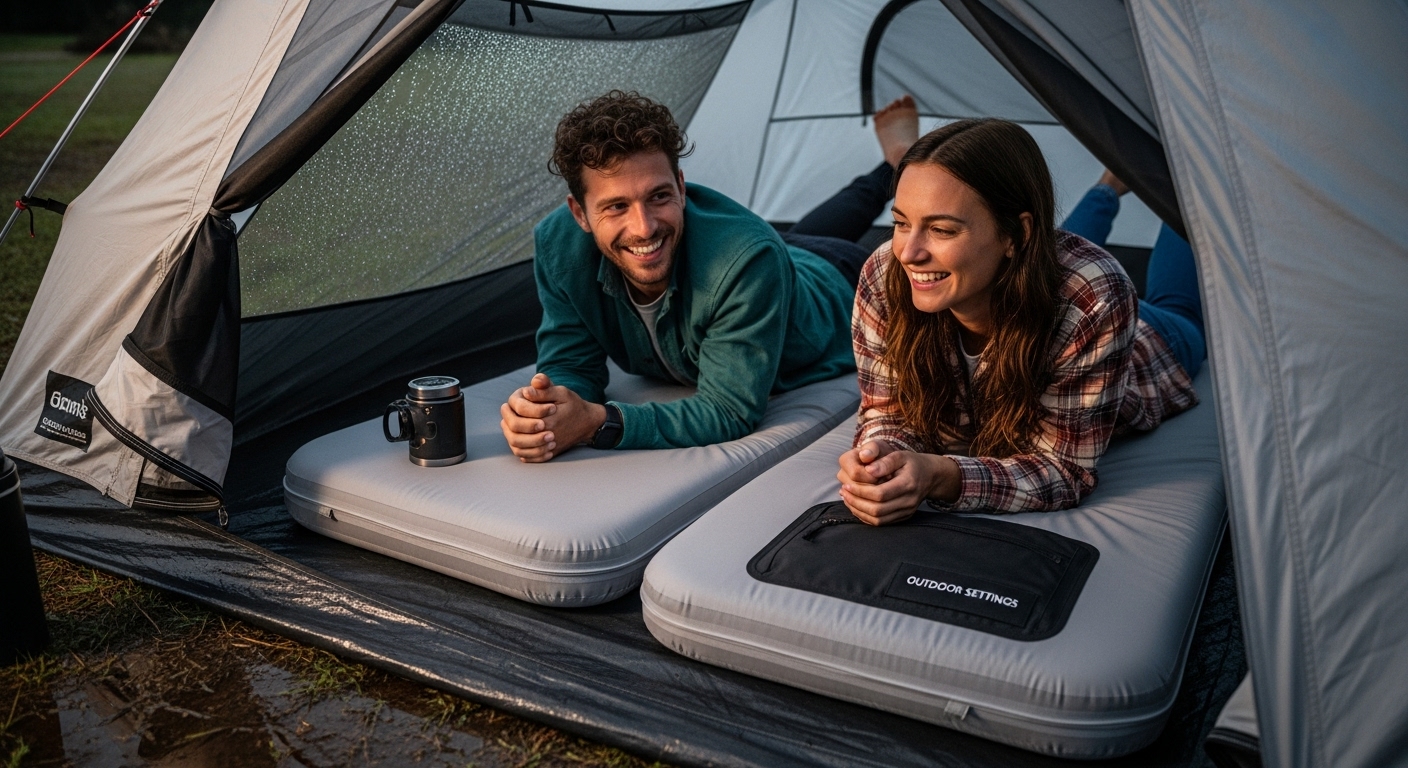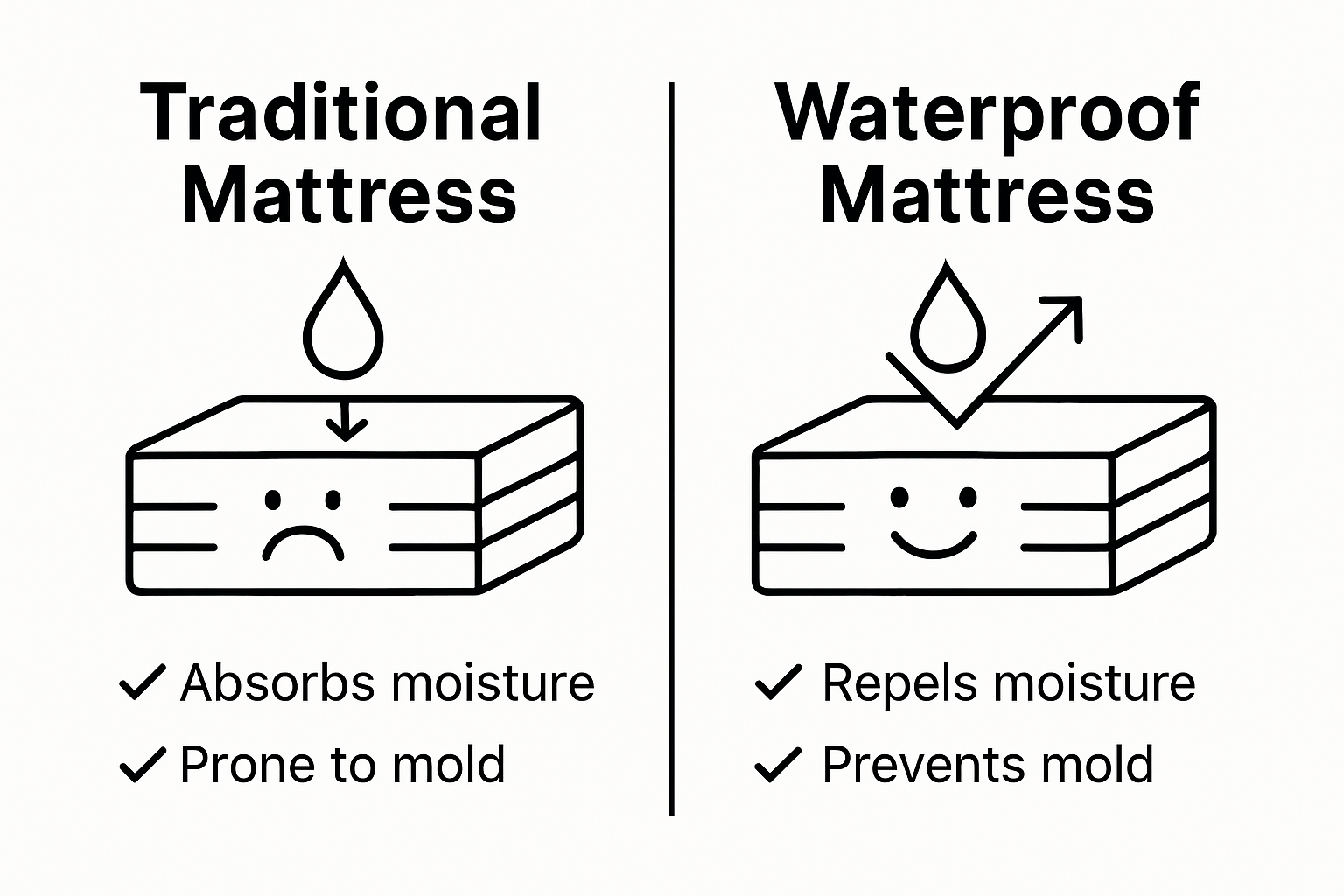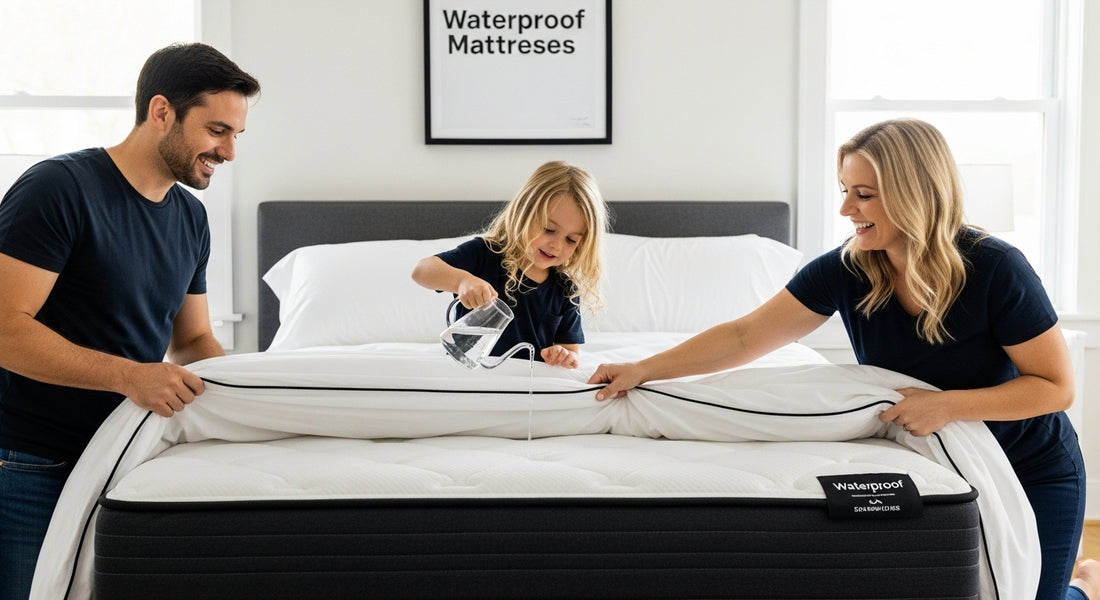Waterproof mattresses are changing the way we think about clean, comfortable sleep surfaces. Most people expect a mattress to soak up spills and sweat over time and yet advanced waterproof designs use specialized polymers and sealed seams to block even microscopic water droplets. The real surprise is these high-tech layers keep the mattress just as breathable and soft as regular models so you get serious protection without any sticky or plastic feel.
Table of Contents
- What Are Waterproof Mattresses And Their Design?
- The Importance Of Waterproof Mattresses In Outdoor Settings
- How Waterproof Mattresses Protect Against Moisture And Damage
- Key Materials Used In Waterproof Mattresses
- Comparing Waterproof Mattresses To Traditional Options
Quick Summary
| Takeaway | Explanation |
|---|---|
| Waterproof mattresses prevent moisture damage | They feature advanced materials that create impermeable barriers against liquid, reducing damage from spills or condensation. |
| Durability and breathability are key features | These mattresses are designed to resist liquids while maintaining comfort through air circulation, ensuring a restful sleep experience. |
| Ideal for outdoor environments | Waterproof mattresses protect against moisture sources like dew and rain, crucial for camping and outdoor activities. |
| Longer lifespan compared to traditional mattresses | Waterproof options reduce the need for frequent replacement due to their resistance to moisture damage and microbial growth. |
| Investing in waterproof technology is cost-effective | Although initially pricier, they save money in the long run by extending the life of sleep equipment and minimizing maintenance. |
What Are Waterproof Mattresses and Their Design?
Waterproof mattresses represent an innovative solution designed to protect sleep surfaces from moisture, spills, and potential damage. Unlike traditional mattresses, these specialized sleep systems incorporate advanced materials and construction techniques that create an impermeable barrier against liquids while maintaining user comfort.
Core Components of Waterproof Mattress Technology
At the heart of waterproof mattresses are strategic material layers that prevent liquid penetration. Scientific research on mattress materials reveals these typically include:
- Specialized polyurethane membrane top layers
- Hydrophobic protective coatings
- Sealed seam construction preventing liquid absorption
These materials work synergistically to create a robust defense against potential moisture intrusion. The polyurethane membrane acts as a microscopic shield, preventing liquid molecules from passing through while allowing air circulation.
This ensures that the mattress remains breathable and comfortable, addressing potential concerns about feeling trapped or overheated.
Design Principles and Performance Considerations
Waterproof mattresses are engineered with multiple performance objectives beyond simple liquid resistance. Manufacturers focus on creating sleep surfaces that maintain core comfort attributes while providing exceptional protection. Durability and breathability become paramount design considerations.
The technical construction involves creating thin, flexible barriers that do not compromise the mattress’s underlying foam or spring structure. For campers and outdoor enthusiasts seeking complete camp mattress care solutions, these mattresses represent an ideal intersection of protection and performance.
Key engineering principles include developing materials that:
- Resist liquid penetration
- Maintain thermal regulation
- Prevent bacterial and mold growth
- Preserve mattress structural integrity
By integrating advanced material science with thoughtful design, waterproof mattresses transform how we approach sleep surface protection, offering peace of mind across various environments from home bedrooms to rugged camping sites.
The Importance of Waterproof Mattresses in Outdoor Settings
Outdoor environments present unique challenges for sleep surfaces, making waterproof mattresses an essential gear component for adventurers and camping enthusiasts. These specialized mattresses provide critical protection against unpredictable moisture conditions that can rapidly compromise sleep comfort and equipment integrity.
Environmental Challenges in Outdoor Sleep Environments
Camping and outdoor recreation research highlights the substantial risks moisture poses to sleep equipment. Outdoor settings expose mattresses to multiple moisture sources including:
- Ground condensation
- Morning dew
- Unexpected rain or humidity
- Accidental liquid spills
- Body perspiration
Without proper protection, these moisture sources can quickly transform a comfortable sleeping surface into a breeding ground for mold, mildew, and bacterial growth. Waterproof mattresses create a critical barrier that prevents these potential health hazards, ensuring a clean and safe sleeping environment.
Performance Benefits in Challenging Terrain
Waterproof mattresses offer substantial advantages beyond basic liquid resistance. For outdoor enthusiasts exploring varied camping environments, these mattresses provide comprehensive protection that extends equipment lifespan and maintains personal comfort.
The innovative design allows campers to sleep confidently in diverse conditions, from humid forest floors to rocky mountain terrains. By preventing moisture absorption, these mattresses maintain their structural integrity and thermal insulation properties, which are crucial for maintaining body temperature and ensuring restful sleep.
Key performance benefits include:
- Rapid moisture evaporation
- Sustained insulation capabilities
- Resistance to microbial growth
- Extended mattress durability
Ultimately, waterproof mattresses transform outdoor sleeping experiences by providing a reliable, hygienic, and comfortable foundation that adapts to the most challenging environmental conditions.

How Waterproof Mattresses Protect Against Moisture and Damage
Waterproof mattresses employ sophisticated protective mechanisms that go far beyond simple surface coverage, creating comprehensive defense systems against potential moisture intrusion and subsequent equipment degradation. These innovative designs represent a critical intersection of material science and practical sleep technology.
Molecular Level Protection Strategies
Environmental health research demonstrates that preventing moisture penetration is crucial for maintaining both equipment integrity and user health. Waterproof mattresses achieve protection through multiple strategic layers:
- Hydrophobic surface treatments
- Microscopic membrane barriers
- Sealed constructional interfaces
- Chemical repellent coatings
The molecular structure of these protective layers actively repels water molecules, creating a dynamic shield that prevents liquid absorption. Specialized polymers integrated into mattress fabrics generate an invisible barrier that redirects moisture while maintaining fabric breathability and comfort.
Comprehensive Damage Prevention Mechanisms
Beyond immediate liquid resistance, waterproof mattresses provide multilayered protection against potential long-term damage. By blocking moisture, these mattresses prevent several critical degradation pathways, including bacterial colonization, material breakdown, and structural compromise.
For outdoor enthusiasts exploring advanced memory foam technologies, understanding these protective mechanisms becomes essential. The mattress functions not just as a sleep surface, but as a proactive defense system against environmental challenges.
Key protective attributes include:
- Preventing microbial growth
- Blocking liquid penetration
- Maintaining thermal regulation
- Preserving material structural integrity
Through intelligent design and advanced material engineering, waterproof mattresses transform passive sleep surfaces into active protective environments, safeguarding both user comfort and equipment longevity across diverse environmental conditions.
Key Materials Used in Waterproof Mattresses
Waterproof mattress technology relies on sophisticated material selections that balance protection, comfort, and performance. Understanding these materials provides insight into how modern sleep surfaces achieve comprehensive moisture resistance while maintaining user comfort and equipment longevity.
Advanced Polymer Technologies
Mattress protection research reveals that contemporary waterproof mattresses utilize cutting-edge polymer technologies designed to create impenetrable moisture barriers. Specialized synthetic materials play a critical role in developing these advanced protective layers:
- Polyurethane membranes
- Thermoplastic polyurethane (TPU) coatings
- Vinyl-based protective layers
- Microporous synthetic fabrics
These polymers are engineered with microscopic structures that allow air circulation while blocking liquid molecules. The molecular design enables breathability without compromising the mattress’s water-resistant properties, ensuring users remain comfortable in diverse environmental conditions.
Functional Material Characteristics
Each material selected for waterproof mattresses undergoes rigorous performance evaluation based on specific functional requirements. Manufacturers prioritize materials that demonstrate:
- Exceptional liquid repellency
- Durability under repeated stress
- Minimal thermal interference
- Lightweight composition
For outdoor enthusiasts exploring advanced memory foam technologies, understanding material science becomes crucial in selecting optimal sleep equipment. Synthetic polymers represent a technological breakthrough, transforming traditional mattress designs into high-performance protective systems.
By combining innovative material engineering with strategic design principles, waterproof mattresses offer a sophisticated solution that adapts to the most challenging environmental conditions while maintaining user comfort and equipment integrity.
Here is a quick reference table outlining the advanced materials commonly used in waterproof mattresses and their key characteristics, making it easier to identify how each contributes to protection and comfort.
| Material Type | Key Properties | Functional Benefit |
|---|---|---|
| Polyurethane Membrane | Microscopic barrier, air-permeable | Blocks liquids, stays breathable |
| Thermoplastic Polyurethane (TPU) | Flexible, durable, lightweight | Strong waterproofing, flexible |
| Vinyl | Highly water-resistant, easy to clean | Simple maintenance, effective seal |
| Microporous Synthetic Fabrics | Lightweight, allows airflow, hypoallergenic | Breathable, comfortable |
| Hydrophobic Coating | Repels liquids on contact | Added moisture resistance |
Comparing Waterproof Mattresses to Traditional Options
Traditional mattresses and waterproof mattresses represent fundamentally different approaches to sleep surface design, with significant variations in material composition, protective capabilities, and long-term performance. Understanding these distinctions helps consumers make informed decisions about their sleep equipment.
The table below compares waterproof mattresses and traditional mattresses, highlighting core structural and performance differences to help readers quickly understand the advantages of waterproof technology.
| Feature | Waterproof Mattresses | Traditional Mattresses |
|---|---|---|
| Moisture Handling | Repels liquids, prevents absorption | Absorbs moisture, prone to dampness |
| Protective Capability | Comprehensive protection against spills | Limited, allows spills to soak in |
| Lifespan | Longer due to protection from damage | Shorter, degrades quicker from moisture |
| Hygiene | Resistant to microbial growth | Can harbor bacteria and mold |
| Breathability | Maintains air circulation | Breathability varies with materials |
| Maintenance Frequency | Low, easy to clean | Higher, more frequent deep cleaning needed |
| Cost Over Time | Higher up front, lower long-term costs | Lower upfront, higher replacement costs |
Structural and Performance Differences
Sleep technology research reveals profound contrasts between standard and waterproof mattress technologies. Traditional mattresses typically absorb moisture, leading to potential degradation, while waterproof options provide active protection:
- Moisture absorption versus repulsion
- Limited versus comprehensive protection
- Shorter functional lifespan
- Higher susceptibility to microbial growth
Waterproof mattresses integrate advanced protective layers that prevent liquid penetration, maintaining structural integrity and hygiene. This fundamental difference extends the mattress lifecycle and preserves user health by blocking potential bacterial and fungal development.
Long-Term Cost and Maintenance Considerations
Beyond immediate protective capabilities, waterproof mattresses offer substantial economic advantages for outdoor enthusiasts exploring camp bedding organization strategies. Replacement frequency becomes a critical factor in understanding total equipment investment.
Traditional mattresses require more frequent replacement due to moisture damage, while waterproof options maintain performance across diverse environmental conditions. The initial higher investment in waterproof technology translates to significant long-term savings and reduced equipment maintenance.
Key comparative attributes include:
- Enhanced durability
- Superior moisture resistance
- Reduced replacement frequency
- Improved hygiene maintenance
Ultimately, waterproof mattresses represent a technological evolution in sleep surface design, offering comprehensive protection that traditional options cannot match, particularly in challenging outdoor environments.

Upgrade Your Outdoor Sleep with Waterproof Comfort from Hazli
If you have ever faced restless nights on damp ground or worried about a ruined mattress during an unexpected storm, you know how important waterproof mattresses truly are. The article showed how moisture, condensation, and bacteria can easily affect your outdoor sleeping experience, making comfort and hygiene hard to maintain. These problems do not have to follow you to your next adventure.

Choose reliable protection for your outdoor trips. At Hazli Collection, we offer advanced memory foam mattresses built for outdoor comfort with the moisture resistance your adventures demand. Our design combines the technical benefits explained in the article with the real-world convenience every camper deserves. Discover how you can stay dry and sleep better on your next trip by browsing our trusted memory foam mattress selection today. Shop now and take control of your comfort before your next journey begins.
Frequently Asked Questions
What are waterproof mattresses?
Waterproof mattresses are specialized sleep surfaces designed to protect against moisture, spills, and damage while maintaining comfort. They utilize advanced materials and construction techniques to create an impermeable barrier against liquids.
How do waterproof mattresses protect against moisture?
Waterproof mattresses employ various protective mechanisms, such as hydrophobic surface treatments, microscopic membrane barriers, and sealed construction, which prevent liquid penetration and bacterial growth while maintaining breathability.
What materials are commonly used in waterproof mattresses?
Common materials in waterproof mattresses include specialized polyurethane membranes, thermoplastic polyurethane (TPU) coatings, and microporous synthetic fabrics that allow air circulation while providing liquid repellency.
How do waterproof mattresses compare to traditional mattresses?
Unlike traditional mattresses, which absorb moisture and can harbor bacteria and mold, waterproof mattresses actively repel liquids, maintain hygiene, and have a longer lifespan due to their protective capabilities.

